Mount Kilimanjaro is found in the Republic of Tanzania in what is known as the Kilimanjaro National Park. Rising up to 19,341 feet above sea level, Mount Kilimanjaro is the highest single free-standing mountain on earth and the highest in Africa. The dormant volcano has 3 volcanic cones – Shire, Mawenzi and Kibo. Although there is no firm agreement about the origin or meaning of the name, historical records dating back to 1860 claim that the name Kilimanjaro was used the local Swahili tribes and adopted by early European explorers such as Johann Ludwig Krapf. The real origin and meaning of the name Kilimanjaro remains a mystery.
As the highest mountain in Africa, Kilimanjaro is one of the top climbing destinations in the world. The mountain receives over 30,000 climbers each year and is one of the top attractions in Tanzania. However, not all who start the hike reach the summit. The main reason for failure is altitude sickness and choosing the wrong route. Most who fail choose to use the shortest Marangu route which takes only 5 days. The 5 days doesn’t allow one to get used to the high altitude and temperatures. To increase one’s chances of reaching the summit, it is better to take the longer routes so as to have enough time to adapt to high altitude and a different climate. Another reason for failure to reach the summit is that many hikers are first time climbers. They don’t prepare well through training and getting the right hiking gear.
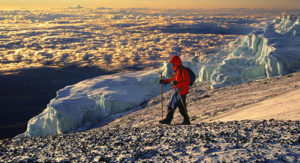 As we already mentioned earlier, Kilimanjaro is made up of 3 distinct volcanic cones. The highest and largest is Kibo at 16,893 feet (5,149 meters) while Shira is the lowest at 13,140 feet (4,005 meters). Kibo is dormant and scientist predict that it will erupt again one day. Shire and Mawenzi are extinct. The Shira center saw its first eruptive activity about 2.5 million years ago and the last major one about 1.9 million years ago. Kibo and Mawenzi both begun eruption about one million years ago. The last activity in Kibo is dated to about 150,000 years ago and was responsible for creating the crater at the cone.
As we already mentioned earlier, Kilimanjaro is made up of 3 distinct volcanic cones. The highest and largest is Kibo at 16,893 feet (5,149 meters) while Shira is the lowest at 13,140 feet (4,005 meters). Kibo is dormant and scientist predict that it will erupt again one day. Shire and Mawenzi are extinct. The Shira center saw its first eruptive activity about 2.5 million years ago and the last major one about 1.9 million years ago. Kibo and Mawenzi both begun eruption about one million years ago. The last activity in Kibo is dated to about 150,000 years ago and was responsible for creating the crater at the cone.
Mount Kilimanjaro is divide into 5 climatic zones which influence the kind of vegetation and creatures therein. Bushland occupy the lower slopes between 2,600 to 5,900 feet. The bushlands are followed by rain-forest between 5,900 to 9,200 feet. Moorland or Heather follows next at 9,200 to 13,100 feet. Then there is the Alpine Desert Zone at between 13,100 to 16,400 feet. Finally, there is the Arctic Zone between 16,400 to 19,300 feet. Mount Kilimanjaro is drained by several streams and rivers. Most of the rivers and streams are found on the more eroded southern park. The main waterbodies are Pangani to the south and Lumi to the west. The shira plateau and lower parts of the mountain contain forests/savanna grasslands that are home to Zebras, warthogs, sunbirds, mongooses, leopards, hyenas, Elephants, duikers, dik-diks, chameleons, Cape buffaloes and Bushbucks. Buffaloes and elephants can be a real threat to mountain climbers.
History of Mount Kilimanjaro and First Hikers
Mount Kilimanjaro may have been known to non-Africans even before the middle ages. Reports by ancient sailors such as Ptolemy mention a spring lake of the Nile and certain “moon mountain”. However, this information has been taken with a grain of salt because it doesn’t clearly differentiate it with other high mountains like those in Ethiopia, the Rwenzori Mountains, Mount Kenya and the Virunga ranges of mountains. More recently in 1519, a Spanish traveler Martín Fernández de Enciso in one of his travels to Mombasa got some interesting information from the locals who traveled in caravans to the interior. They told him that on the West of Mombasa stood the Ethiopian Mount Olympus and beyond it the Mountains of the Moon.
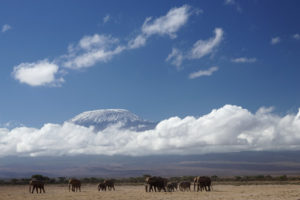 The first Europeans to attempt to reach it were two German missionaries – Krapf and Johannes Rebmann of Mombasa. Rebmann was the first to report the existence of Mount Kilimanjaro in 1848. According to written records and a dairy, they only managed to see it from afar. In August 1861, a Prussian Officer Baron Karl Klaus von der Decken and an English geologist R. Thornton attempted to climb the mountain but could only get to 8,200 feet because of bad weather. Von der Decken tried again in 1862 with Otto Kersten and this time reached 14,000 feet.
The first Europeans to attempt to reach it were two German missionaries – Krapf and Johannes Rebmann of Mombasa. Rebmann was the first to report the existence of Mount Kilimanjaro in 1848. According to written records and a dairy, they only managed to see it from afar. In August 1861, a Prussian Officer Baron Karl Klaus von der Decken and an English geologist R. Thornton attempted to climb the mountain but could only get to 8,200 feet because of bad weather. Von der Decken tried again in 1862 with Otto Kersten and this time reached 14,000 feet.
Later in August 1871, Charles New, an Englishman became the first European to reach the equatorial snows of Mount Kilimanjaro. This was at an elevation of 13,000 feet. Later in June 1887, an Austrian Lieutenant Ludwig von Höhnel and the Hungarian Count Sámuel Teleki made an attempt to climb the mountain. Höhnel stopped at 16,240 feet but Teleki continued up to the snow at 17,400 feet. A German professor of geology Hans Meyer followed in 1887 and was able to reach the edge of the ice sheets on Kibo. Unfortunately, he didn’t have the required equipment and was forced to turn back. Meyer tried again the next year with a cartographer know as Oscar Baumann, but everything was aborted when the two were held hostage and ransomed during a revolt against German rule by Arab and Swahili populations.
Not to be deterred, a German explore known as Otto Ehrenfried Ehlers and American naturalists Dr. Abbott approached the mountain summit from the northwest in 1888. Abbot turned back earlier while Ehlers continued. He initially claimed to have reached the summit rim but withdrew his claim after criticism. Meyer (the gentleman who was kidnapped) returned in 1889 for a third attempt with an 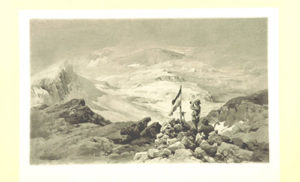 Austrian mountaineer Ludwig Purtscheller. This time everything was put in place to ensure that they didn’t have to descend too far in case they had to withdraw and to get back again. The duo established multiple campsites with waiting porters and food supplies. The two reached near the crater rim on the 3rd of October 1889 but turned back to regroup because of exhaustion. They reached the highest summit on the southern rim 3 days later. With this remarkable achievement, they were the first to confirm that a crater existed in Kibo. After this success, the two attempted to climb the more technically challenging Mawenzi peak but could only reach its subsidiary peak (Klute Peak). The two climbed Kibo once again on the 18th of October 1889 with the intention of studying the crater more thoroughly. Their expedition lasted 16 days in total and were assisted by a local known as Mwini Amani. A local named Yohani Kinyala Lauwo from Marangu us often recognized as a co-first ascendant of the mountain along with Meyer and Purtscheller based on photographs relating to the first successful ascent. Another local Mwini was responsible for cooking and ensuring that the different campsites had supplies (firewood and water).
Austrian mountaineer Ludwig Purtscheller. This time everything was put in place to ensure that they didn’t have to descend too far in case they had to withdraw and to get back again. The duo established multiple campsites with waiting porters and food supplies. The two reached near the crater rim on the 3rd of October 1889 but turned back to regroup because of exhaustion. They reached the highest summit on the southern rim 3 days later. With this remarkable achievement, they were the first to confirm that a crater existed in Kibo. After this success, the two attempted to climb the more technically challenging Mawenzi peak but could only reach its subsidiary peak (Klute Peak). The two climbed Kibo once again on the 18th of October 1889 with the intention of studying the crater more thoroughly. Their expedition lasted 16 days in total and were assisted by a local known as Mwini Amani. A local named Yohani Kinyala Lauwo from Marangu us often recognized as a co-first ascendant of the mountain along with Meyer and Purtscheller based on photographs relating to the first successful ascent. Another local Mwini was responsible for cooking and ensuring that the different campsites had supplies (firewood and water).
With this initial success by Hans Meyer and Ludwig Purtscheller, everything became much easier for everyone. Their success paved way for Fritz Klute and Eduard Hans Oehler to become the first Europeans to reach the highest summit of Mawenzi in July 29th of 1912. The two named it after Hans Meyer.
Dangers, Deaths and Records while hiking Mount Kilimanjaro
Mount Kilimanjaro is among the seven highest summits in the world. The other summits are Everest, Aconcagua, Denali, Elbrus and Carstensz Pyramid. Mount Kilimanjaro stands out because it is a free 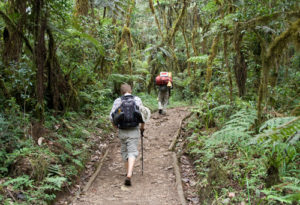 standing mountain. Most of the other mountains are part of a range of mountains formed by plate tectonics (The earth’s crust colliding and pushing up rocks). Kilimanjaro on the other hand was formed as result of volcanic activity. This is where molten rock erupts and piles up on the earth’s surface forming mountains. Kilimanjaro is the easiest to climb among the 7 mountains and because of that is very popular with both first time and experienced hikers. One doesn’t need technical skills or equipment like ice axe, harness, ropes or crampons. It’s all about mental preparedness and hiking/walking up to the summit.
standing mountain. Most of the other mountains are part of a range of mountains formed by plate tectonics (The earth’s crust colliding and pushing up rocks). Kilimanjaro on the other hand was formed as result of volcanic activity. This is where molten rock erupts and piles up on the earth’s surface forming mountains. Kilimanjaro is the easiest to climb among the 7 mountains and because of that is very popular with both first time and experienced hikers. One doesn’t need technical skills or equipment like ice axe, harness, ropes or crampons. It’s all about mental preparedness and hiking/walking up to the summit.
Although climbing Mount Kilimanjaro is not as difficult as conquering the Andes or Himalayas, strong winds, low temperatures and high elevation can present difficulties for even the most fit of trekkers. 77 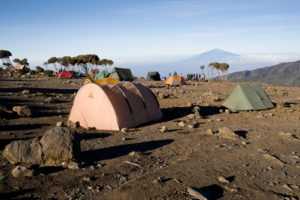 percent of successful hikers experience high altitude sickness. This sickness is characterized by loss of appetite, vomiting, nausea and diarrhea. There have been a few deaths through rockslides and on steep parts of the mountain. The Arrow Glacier route was closed for many years and only reopened in December 2007 because it was deemed dangerous for hikers. In total, 25 people died between 1996 to 2003 while attempting to reach the summit of Mount Kilimanjaro. Most died from high altitude related sicknesses, trauma, appendicitis and pneumonia. The death rate is 0.1 per 100 climbers.
percent of successful hikers experience high altitude sickness. This sickness is characterized by loss of appetite, vomiting, nausea and diarrhea. There have been a few deaths through rockslides and on steep parts of the mountain. The Arrow Glacier route was closed for many years and only reopened in December 2007 because it was deemed dangerous for hikers. In total, 25 people died between 1996 to 2003 while attempting to reach the summit of Mount Kilimanjaro. Most died from high altitude related sicknesses, trauma, appendicitis and pneumonia. The death rate is 0.1 per 100 climbers.
Which is the best route for climbing Mount Kilimanjaro? There are 6 major routes for climbing Mount Kilimanjaro. They include the Machame Route, Shira Route, Northern Circuit, Lemosho route, Rongai Route and Marangu route. Machame is the most popular route but can be very crowded during the peak 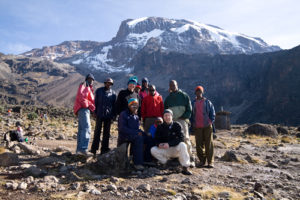 season. The Shira Route takes 8 days and passes through the pristine wilderness of the Shira Plateau. It is an excellent route for those who want to avoid the crowds and enjoy beautiful scenery. The Northern Circuit is an 8 to 9-day hike. Almost everyone who uses this route gets to the summit. It takes about 8 days to reach the summit from the Lemosho route and it is generally considered a more relaxed route to follow. The Lemosho route also presents hikers with beautiful scenery and forests. The Rongai Route is one of the most popular routes taking only 6 days to get to the summit. Marangu used to be the most popular route before it was overtaken by Machame. The route rewards hikers with amazing views but overcrowding has reduced the overall quality of the hike of late.
season. The Shira Route takes 8 days and passes through the pristine wilderness of the Shira Plateau. It is an excellent route for those who want to avoid the crowds and enjoy beautiful scenery. The Northern Circuit is an 8 to 9-day hike. Almost everyone who uses this route gets to the summit. It takes about 8 days to reach the summit from the Lemosho route and it is generally considered a more relaxed route to follow. The Lemosho route also presents hikers with beautiful scenery and forests. The Rongai Route is one of the most popular routes taking only 6 days to get to the summit. Marangu used to be the most popular route before it was overtaken by Machame. The route rewards hikers with amazing views but overcrowding has reduced the overall quality of the hike of late.
Additional information and interesting facts about Mount Kilimanjaro
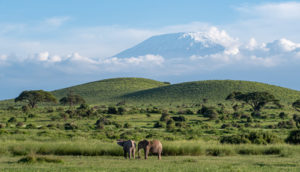 Mount Kilimanjaro is commonly known as the roof of Africa because it towers over the whole of the continent. The mountain is so large that if you were to stand at the foot, you wouldn’t really see it. The mountain is not clearly visible from any part of Tanzania unless one climbs it. To have the full view of the mountain, one needs to go to Kenya’s Amboseli National Park. Those who are lucky may see its full size while traveling on a plane.
Mount Kilimanjaro is commonly known as the roof of Africa because it towers over the whole of the continent. The mountain is so large that if you were to stand at the foot, you wouldn’t really see it. The mountain is not clearly visible from any part of Tanzania unless one climbs it. To have the full view of the mountain, one needs to go to Kenya’s Amboseli National Park. Those who are lucky may see its full size while traveling on a plane.
What is the cost of climbing Mount Kilimanjaro? The cost of climbing Mount Kilimanjaro depends on whether you are climbing an available group or on a private arrangement. In general, the cost is $2,500 per person if in a group. Private climbs are more expensive and will also depend on which route you intend on using.
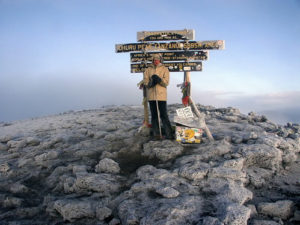 When is the best time to climb Mount Kilimanjaro? Mount Kilimanjaro is open to hikers throughout the year. However, the best time to climb is from July to October. This is also the best time for game viewing in Tanzania’s other national parks. March to May is considered a rainy season and not excellent if you want to get clear views of the mountain. The rest of the months are also great for hiking. If you want to reach the summit on a clear day, then you might want to consider climbing between July and October. There are more crowds around this time and if you want a more private trek, then you might want to book your hike in the other months.
When is the best time to climb Mount Kilimanjaro? Mount Kilimanjaro is open to hikers throughout the year. However, the best time to climb is from July to October. This is also the best time for game viewing in Tanzania’s other national parks. March to May is considered a rainy season and not excellent if you want to get clear views of the mountain. The rest of the months are also great for hiking. If you want to reach the summit on a clear day, then you might want to consider climbing between July and October. There are more crowds around this time and if you want a more private trek, then you might want to book your hike in the other months.
How long will it take to hike Mount Kilimanjaro? It depends on the route you choose to take and your level of fitness. The easier routes can take only 4 nights but most people take between 6 to 9 days to get to the summit. As already noted early, Mount Kilimanjaro can be conquered by anyone who is reasonably fit and with the right mentality. Certain routes can be very challenging and will test your endurance and stamina. Before attempting to climb Mount Kilimanjaro, ensure that you have the right climbing equipment and are mentally prepared to deal with high altitude sickness. You might want to consult your medical doctor for an overall fitness test.


I love kilimanjaro